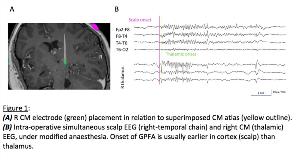Cortex Leads Thalamus in Tonic Seizures of Lennox-Gastaut Syndrome
Abstract number :
2.036
Submission category :
3. Neurophysiology / 3C. Other Clinical EEG
Year :
2018
Submission ID :
501353
Source :
www.aesnet.org
Presentation date :
12/2/2018 4:04:48 PM
Published date :
Nov 5, 2018, 18:00 PM
Authors :
Linda J. Dalic, University of Melbourne; Aaron Warren, University of Melbourne; Annie Roten, University of Melbourne; Wes Thevathasan, Austin Health; Kristian Bulluss, The University of Melbourne; and John Archer, University of Melbourne
Rationale: Tonic seizures and generalised paroxysmal fast activity (GPFA), characterised by diffuse fast activity on scalp EEG, are key features of Lennox-Gastaut syndrome (LGS), a severe epilepsy phenotype. Our prior imaging studies have confirmed cortex and thalamus are both involved (Front Neurol, 2014; 5:225), but the role of these structures in initiation of epileptic activity has been controversial. We aimed to assess the relative role of cortex and thalamus (centromedian nucleus; CM) in epileptic activity of LGS. This is part of the larger ESTEL study (Electrical Stimulation of the Thalamus in Epilepsy of the Lennox-Gastaut phenotype). Methods: Five patients with LGS undergoing bilateral CM deep brain stimulation electrode insertion had simultaneous, intraoperative EEG from scalp and thalamus (17-34 minutes). Remifentanil/isoflurane anaesthesia permitted visualisation of epileptic activity. Onset of discharges was marked manually, at both scalp (‘cortex’) and thalamus. Results: GPFA/tonic seizures were recorded in 4/5 patients. 55 GPFA/tonic seizures were analysed. GPFA was observed earlier on scalp 67.2% (37/55) samples. The average lag of thalamic to cortical discharges was 92.7 ± 86.8 msec. Three discharges were exclusively noted in cortical electrodes. 14 discharges had simultaneous onset in thalamus and scalp. Thalamic-only GPFA was noted in one sample. Conclusions: Epileptic activity of LGS is detectable in CM of thalamus, confirming that the CM is part of the epileptic network of LGS. Scalp EEG discharges, representing adjacent cortical activity, usually precede or occur simultaneously with thalamic discharges. This is consistent with EEG-fMRI data and suggests that the cortex drives GPFA and tonic seizures in LGS patients. This finding is relevant to neuromodulation studies of LGS using responsive stimulation, which require a detectable EEG event to trigger stimulation. Funding: National Health and Medical Research Council project grant #1108881

.tmb-.jpg?Culture=en&sfvrsn=d5b3f0b9_0)